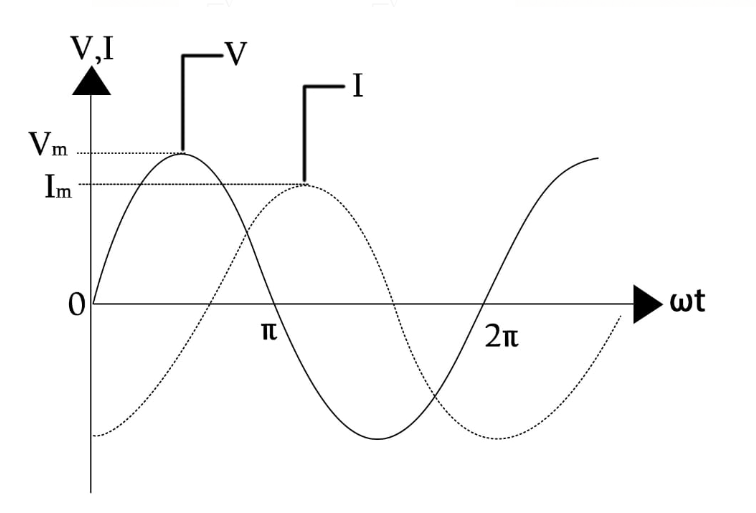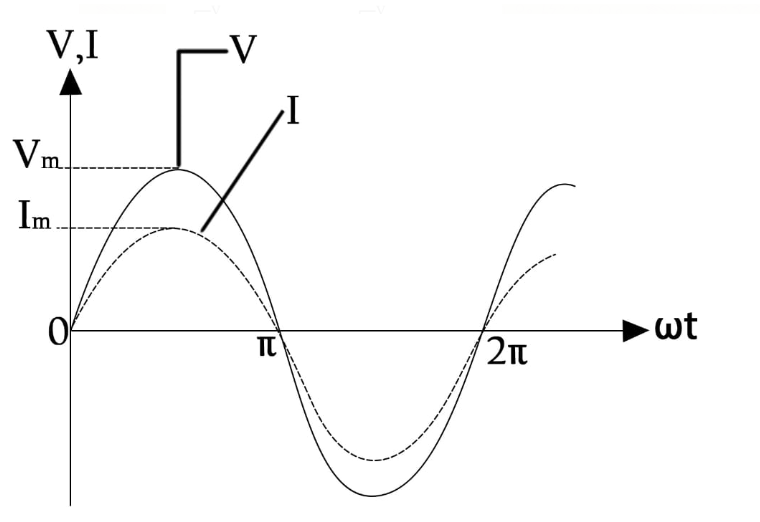
The phase relationship between current and voltage in a pure resistive circuit is best represented by.
A. 
B. 
C. 
D . 
Answer
120.9k+ views
Hint: A pure resistive circuit consists of an AC source and a resistor. There is no phase difference between voltage and current and the current and voltage is said to be in-phase.
Complete step by step answer:
It is given that the circuit is pure resistive which means that there is a resistor in the circuit along with an AC source.

Here ${\text{I}}$ is the current through the circuit and AC source has ${{\text{V}}_{\text{0}}}$ is the voltage difference and ${\text{R}}$ is resistance of the circuit.
Apply Kirchhoff’s law in the given circuit.

Appling Kirchhoff’s law,
$
{V_0}\sin \omega t - I \cdot R = 0 \\
I = \left( {\dfrac{{{V_0}}}{R}} \right)\sin \omega t \\
$
So, here we can see that current in the same phase as of voltage but is less in magnitude then voltage.
The phase diagram in which both voltage and current are in the same phase and also the current is having lesser value than voltage. Let us observe each of the options and see which one is the correct answer for this problem.
In option A the value of current is lesser than that of voltage but there is phase difference in the diagram.
In option B the value of current is lesser than that of voltage but there is a phase difference that is present in the phase diagram.
In option C the value of current is lesser than that of voltage and the phase difference is zero in the phase diagram.
In option D the value of current is lesser than voltage but there is a phase difference in the phase diagram.
Therefore, option C is the correct answer for this problem.
Note: A phase diagram is used to show the relationship between two or more sine waves having the same frequency. While applying Kirchhoff’s rule if we follow the flow of current then we are proceeding from higher potential to the lower potential of the source.
Complete step by step answer:
It is given that the circuit is pure resistive which means that there is a resistor in the circuit along with an AC source.

Here ${\text{I}}$ is the current through the circuit and AC source has ${{\text{V}}_{\text{0}}}$ is the voltage difference and ${\text{R}}$ is resistance of the circuit.
Apply Kirchhoff’s law in the given circuit.

Appling Kirchhoff’s law,
$
{V_0}\sin \omega t - I \cdot R = 0 \\
I = \left( {\dfrac{{{V_0}}}{R}} \right)\sin \omega t \\
$
So, here we can see that current in the same phase as of voltage but is less in magnitude then voltage.
The phase diagram in which both voltage and current are in the same phase and also the current is having lesser value than voltage. Let us observe each of the options and see which one is the correct answer for this problem.
In option A the value of current is lesser than that of voltage but there is phase difference in the diagram.
In option B the value of current is lesser than that of voltage but there is a phase difference that is present in the phase diagram.
In option C the value of current is lesser than that of voltage and the phase difference is zero in the phase diagram.
In option D the value of current is lesser than voltage but there is a phase difference in the phase diagram.
Therefore, option C is the correct answer for this problem.
Note: A phase diagram is used to show the relationship between two or more sine waves having the same frequency. While applying Kirchhoff’s rule if we follow the flow of current then we are proceeding from higher potential to the lower potential of the source.
Recently Updated Pages
Structure of Atom: Key Models, Subatomic Particles, and Quantum Numbers

Young's Double Slit Experiment Step by Step Derivation

Difference Between Circuit Switching and Packet Switching

Difference Between Mass and Weight

JEE Main Participating Colleges 2024 - A Complete List of Top Colleges

JEE Main Maths Paper Pattern 2025 – Marking, Sections & Tips

Trending doubts
JEE Mains 2025: Check Important Dates, Syllabus, Exam Pattern, Fee and Updates

JEE Main Login 2045: Step-by-Step Instructions and Details

JEE Main Chemistry Question Paper with Answer Keys and Solutions

JEE Main Exam Marking Scheme: Detailed Breakdown of Marks and Negative Marking

JEE Main 2023 January 24 Shift 2 Question Paper with Answer Keys & Solutions

JEE Main Chemistry Exam Pattern 2025

Other Pages
JEE Advanced Marks vs Ranks 2025: Understanding Category-wise Qualifying Marks and Previous Year Cut-offs

JEE Advanced 2025: Dates, Registration, Syllabus, Eligibility Criteria and More

Learn About Angle Of Deviation In Prism: JEE Main Physics 2025

JEE Main 2025: Conversion of Galvanometer Into Ammeter And Voltmeter in Physics

Dual Nature of Radiation and Matter Class 12 Notes CBSE Physics Chapter 11 (Free PDF Download)

Electric field due to uniformly charged sphere class 12 physics JEE_Main




